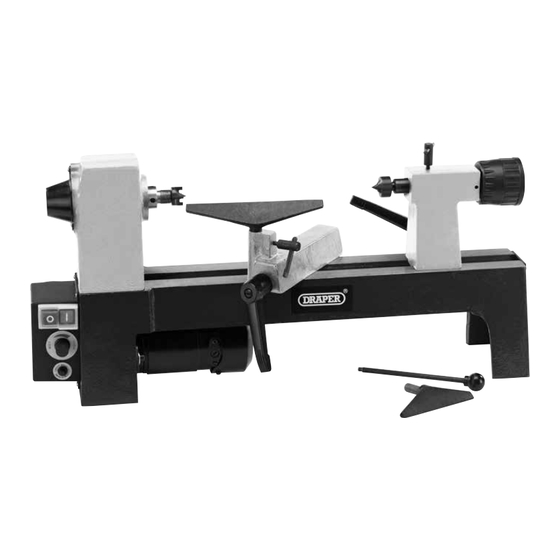
Summarization of Contents
1. TITLE PAGE
1.1 INTRODUCTION
Provides details about the user manual, stock number, and part number for the lathe.
1.2 REVISION HISTORY
Details the publication and revision dates of the user manual.
1.3 UNDERSTANDING THIS MANUAL'S SAFETY CONTENT
Explains the meaning of WARNING and CAUTION symbols used in the manual.
1.4 COPYRIGHT NOTICE
Outlines the copyright and reproduction permissions for the manual.
3. WARRANTY
3.1 WARRANTY
Details the warranty terms, conditions, and exclusions for the product.
4. INTRODUCTION
4.1 SCOPE
Defines the intended use of the machine and what constitutes misuse.
4.2 SPECIFICATION
Lists detailed technical specifications including dimensions, speed, weight, and noise levels.
4.3 HANDLING AND STORAGE
Provides guidance on safe handling, storage, and environmental considerations for the product.
5. HEALTH AND SAFETY INFORMATION
5.1 GENERAL SAFETY INSTRUCTIONS FOR POWER TOOL USE
Covers essential safety precautions for operating any power tool, including work area, PPE, and concentration.
5.2 ADDITIONAL SAFETY INSTRUCTIONS FOR WOOD LATHES
Specific safety advice for wood lathes: eye protection, masks, keeping hands clear, sharp chisels, guards, unplugging, dry conditions, and securing work.
5.3 RESIDUAL RISK
Explains the inherent residual risks associated with power tools that require caution.
5.4 CONNECTION TO THE POWER SUPPLY
Details safe connection procedures, plug fuse replacement, earthing requirements, and extension lead usage for the lathe.
6. TECHNICAL DESCRIPTION
6.1 IDENTIFICATION
Identifies and labels the various parts of the wood lathe using a diagram.
7. UNPACKING AND CHECKING
7.1 PACKAGING
Instructions for carefully removing the product from packaging and checking for damage.
7.2 WHAT'S IN THE BOX
Lists all the components and accessories included with the wood lathe.
8. PREPARING THE WOOD LATHE
8.1 DRIVE SPUR
Step-by-step guide on how to insert and remove the drive spur for the headstock and tailstock.
8.2 FACE PLATE
Instructions on how to attach the face plate to the headstock spindle using a spanner.
9. SETTING THE WOOD LATHE
9.1 CHANGING SPEED
Explains how to adjust the spindle speed using the variable speed dial while the machine is running.
9.2 MOVING THE TAILSTOCK
Details how to slide the tailstock along the bed and adjust the live spur position.
9.3 ADJUSTING THE TOOL REST
Guides on adjusting the tool rest's position, height, and angle for optimal turning.
10. BASIC WOOD TURNING
10.1 SPINDLE TURNING
Step-by-step instructions for preparing wood and setting up for basic spindle turning operations.
10.2 USING WOODWORKING CHISELS
Introduces the six common types of woodturning chisels and their features.
10.3 THE THEORY OF TURNING
Explains the difference between cutting and scraping chisels and their applications.
10.4 KNOWING WHEN TO CUT AND WHEN TO SCRAPE
Discusses the two approaches to turning (circumference vs. diameter) and when to use cutting or scraping.
10.5 POSITIONING THE TOOL REST FOR CIRCUMFERENCE TURNING
Details correct tool rest positioning for circumference turning to avoid chatter and kickback.
10.6 POSITIONING THE TOOL REST FOR CIRCUMFERENCE SCRAPING
Explains correct tool rest positioning for circumference scraping, focusing on chisel angle and avoiding errors.
10.7 POSITIONING CHISEL AND TOOL REST FOR DIAMETER SCRAPING
Details correct positioning for diameter scraping, emphasizing working left of centre and tool rest height.
10.8 USING THE GOUGE CHISEL
Guides on using the gouge chisel for rough turning, shaping cuts, and scraping with correct angles.
10.9 USING A SKEW CHISEL
Instructions on using the skew chisel for making finished cuts, vees, beads, and square shoulders.
10.10 USING A PARTING CHISEL
Explains the primary use of the parting chisel for cutting straight into or through the workpiece.
10.11 USING SCRAPING CHISELS
Introduces spear point, round nose, and flat nose chisels for fine scraping and delicate operations.





Need help?
Do you have a question about the 60988 and is the answer not in the manual?
Questions and answers